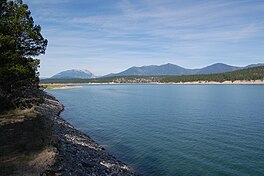Lake Koocanusa
| Lake Koocanusa | |
|---|---|
 | |
| Location | Montana / British Columbia |
| Coordinates | 48°55′N 115°11′W / 48.92°N 115.18°W |
| Lake type | reservoir |
| Primary inflows | Kootenay River (Canada) |
| Primary outflows | Kootenai River (USA) |
| Basin countries | United States, Canada |
| Surface elevation | 2,459 feet (750 m) |
Lake Koocanusa (KUU-KAN-U-S-A) is a reservoir in British Columbia (Canada) and Montana (United States) formed by the damming of the Kootenai River by the Libby Dam in 1972. The Dam was formally dedicated by President Gerald Ford on August 24, 1975.[1]

The lake is formed north of the dam, reaching 48 miles (77 km) to the Canada–United States border and 42 miles (68 km) further into British Columbia. The lake holds 13% of the water in the Columbia River system. The town of Rexford was moved, as well as the Great Northern Railway line. The town of Waldo, British Columbia is now covered by the lake. What was once a barrier to river travel, Jennings Canyon is now inundated by the lake.[2] The Elk River joins the Kootenay River in the northern part of Lake Koocanusa, within Canadian territory.
Lake Koocanusa was named in a contest won by Alice Beers of Rexford, Montana.[1] The name is made from the first three letters of the Kootenay (alternately, Kootenai) River, Canada, and USA. Some confusion around the pronunciation of the lake exists[3] and in an effort to acknowledge truth and reconciliation, locals have been urging people to pronounce the USA portion of the name the same way that you would pronounce the abbreviation.[citation needed]
Lake Koocanusa was built as a joint project of the U.S. and Canada. It is 26 km (16 mi) from Libby, Montana, also on the Kootenai River, from which the dam gets its name. Libby Dam has a Visitors Center and can be accessed by the Lake Koocanusa Scenic Byway which begins in the nearby town of Libby, Montana.
The Pacific Northwest National Scenic Trail follows Highway 37 along the east side of the lake before crossing over the Lake Koocanusa Bridge and climbing up Webb Mountain.
Selenium contamination[edit]
According to a March 8, 2021 article in The Narwhal, concerns have been raised about selenium pollution leaching from Teck Resources' Elk Valley open pit coal mines' waste rock, which is upstream from the lake system.[4] A September 24, 2020 Montana Department of Environmental Quality presentation to the Board of Environmental Review Meeting, reported that the 95% of the selenium coming into Lake Koocanusa originates from the Elk River—"which has been contaminated by current and historic coal mining in the Elk Valley." The average selenium levels in Lake Koocanusa were 1 part per billion. Montana has established new standards for selenium—0.8 parts per billion.[4][5] Because of the high bioaccumulation of selenium in fish, excessive levels of selenium in an aquatic ecosystem has implications for human health.[6][7] In the spring of 2020, Teck Resources, had "reported a dramatic decline in adult westslope cutthroat trout in Elk Valley waterways closest to its mines".[4] Since 2015, British Columbia and Montana have agreed to adopt aligned standards for selenium levels by 2020.[8] Montana's has been in force since the fall of 2020, but British Columbia has not aligned their standards yet.[8]
Fish[edit]
The lake supports a wide variety of fish species. Below is a table detailing the various fish species which may be encountered on the lake.[9]
| Species | Family | Native to MT |
|---|---|---|
| Brook Trout | Trout | Introduced |
| Bull Trout | Trout | Native |
| Burbot | Codfish | Native |
| Kokanee | Trout | Introduced |
| Largemouth Bass | Sunfish | Introduced |
| Largescale Sucker | Sucker | Native |
| Longnose Dace | Minnow | Native |
| Longnose Sucker | Sucker | Native |
| Mountain Whitefish | Trout | Native |
| Northern Pike | Pike | Introduced |
| Northern Pike Minnow | Minnow | Native |
| Peamouth | Minnow | Native |
| Pumpkinseed | Sunfish | Introduced |
| Rainbow Trout | Trout | Introduced |
| Redside Shiner | Minnow | Native |
| Westslope Cutthroat Trout | Trout | Native |
| Yellow Perch | Perch | Introduced |
See also[edit]
References[edit]
- ^ a b "Remarks at Dedication Ceremonies for the Libby Dam, Libby, Montana. | the American Presidency Project".
- ^ "Libby Dam - the Dams | Balance of Power". Archived from the original on 2011-06-29. Retrieved 2011-07-12.
- ^ "Koocanusa". Sesquiotica. January 19, 2012.
- ^ a b c Cruickshank, Ainslie (March 8, 2021). "B.C. under pressure as U.S. EPA releases selenium pollution standard for water near Elk Valley coal mines". The Narwhal. Retrieved March 8, 2021.
- ^ Kelly, Myla; Sullivan, Lauren (September 24, 2020). Establishing Selenium Standards for Lake Koocanusa and Kootenai River that Protect Aquatic Life (PDF). Montana Department of Environmental Quality Board of Environmental Review Meeting (Report). Water Quality Standards & Modeling Section. Retrieved March 8, 2021.
- ^ Hamilton, Steven J. (2004-06-29). "Review of selenium toxicity in the aquatic food chain". Science of the Total Environment. 326 (1): 1–31. Bibcode:2004ScTEn.326....1H. doi:10.1016/j.scitotenv.2004.01.019. ISSN 0048-9697. PMID 15142762.
- ^ Gribble, Matthew; Karimi, Roxanne; Feingold, Beth; Nyland, Jennifer; O'Hara, Todd; Gladyshev, Michail; Chen, Celia (October 8, 2015). "Mercury, selenium and fish oils in marine food webs and implications for human health". Journal of the Marine Biological Association of the United Kingdom. 1 (96): 43–59. doi:10.1017/S0025315415001356. PMC 4720108. PMID 26834292 – via Cambridge.[dead link]
- ^ a b Cruickshank, Ainslie (October 8, 2020). "B.C. stalling on new rules for selenium pollution from coal mines, environmental groups say". The Narwhal. Retrieved March 8, 2021.
- ^ "FISHMT :: Waterbody Details". myfwp.mt.gov. Retrieved 2022-06-17.
External links[edit]
- The Libby, Montana, web site with more information about Lake Koocanusa
- Libby Dam, United States Army Corps of Engineers


 French
French Deutsch
Deutsch
